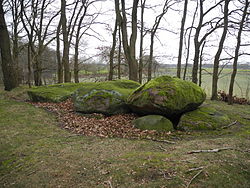Great stone grave Hüven-Süd
| Great stone grave Hüven-Süd Hüvener mill | ||
|---|---|---|
|
|
||
| Coordinates | 52 ° 46 '37.4 " N , 7 ° 33' 30.5" E | |
| place | Hüven , Lower Saxony , Germany | |
| Emergence | 3500 to 2800 BC Chr. | |
| Sprockhoff no. | 843 | |
The large stone grave Hüven-Süd (also called Hüvener Mühle) is either a passage grave or a large dolmen with the Sprockhoff no. 843. It originated in the Neolithic between 3500 and 2800 BC. And is a megalithic system of the funnel beaker culture (TBK). Neolithic monuments are an expression of the culture and ideology of Neolithic societies. Their origin and function are considered to be the hallmarks of social development.
The large stone grave is located west of Lähdener Strasse (L 65) on the Hüvener Mühle road , south of Hüven in the Emsland district in Lower Saxony .
The approximately 5.0 × 2.0 meter northwest-southeast oriented chamber is located in the remains of a 22 × 16 meter hill, of which no stones have been preserved from the border or entrance. Nine upper edges of the bearing stone can be seen. The three capstones are still in situ .
See also
- Volbers Hünensteine
- Nordic megalithic architecture
- The complex is on the street of the megalithic culture
literature
- Anette Bußmann : Stone Age witnesses. Travel to the prehistory of northwest Germany. Isensee, Oldenburg 2009, ISBN 978-3-89995-619-1 , p. 70.
- Ernst Sprockhoff : Atlas of the megalithic tombs Germany. Part 3: Lower Saxony - Westphalia. Habelt, Bonn 1975, ISBN 3-7749-1326-9 , p. 97.
Web links
Individual evidence
- ^ Johannes Müller : Neolithic Monuments and Neolithic Societies. In: Hans-Jürgen Beier (Ed.); Working group Neolithic: Varia neolithica. Part VI: Neolithic Monuments and Neolithic Societies: Contributions from the meeting of the Neolithic Working Group during the annual conference of the North-West German Association for Antiquity Research in Schleswig, October 9-10, 2007 (= contributions to the prehistory and early history of Central Europe. Volume 56). Beier & Beran, Langenweissbach 2009, ISBN 978-3-941171-28-2 , p. 15.

